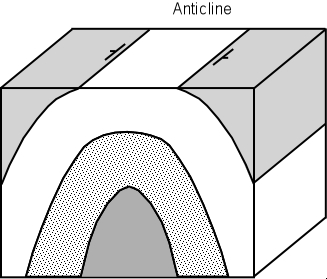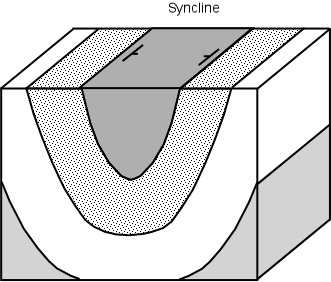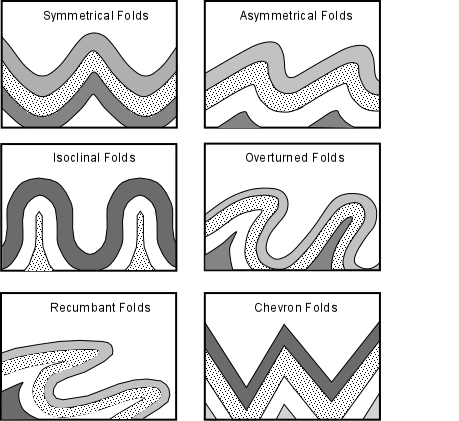Deformation of Rocks
Deformation of Rocks
go back to Contents of Entire Course...
Stress and Strain
Stages of Deformation
Brittle-Ductile
Properties of the Lithosphere
Deformation in Progress
Evidence of Former Deformation
Fracture of Brittle Rocks
Normal Faults
Horsts and Gabens
Half-Grabens
Reverse Faults
Thrust Fault
Strike Slip Faults
Transform-Faults
Evidence of Movement on Faults
Folding of Ductile Rocks
Monoclines
Anticlines
Synclines
Geometry of Folds
Classification of Folds
The Relationship
Between Folding and Faulting
Folds and Topography
see also deformation images in Geological Processes..
adapted to HTML from lecture notes of Prof. Stephen A. Nelson Tulane University
Within the Earth rocks are continually being subjected to forces that tend to bend them, twist them, or fracture them. When rocks bend, twist or fracture we say that they deform (change shape or size). The forces that cause deformation of rock are referred to as stresses (Force/unit area). So, to understand rock deformation we must first explore these forces or stresses.
Stress and Strain
Stress is a force applied over an area. One type of stress that we are all used to is a uniform stress, called pressure. A uniform stress is a stress wherein the forces act equally from all directions. In the Earth the pressure due to the weight of overlying rocks is a uniform stress, and is sometimes referred to as confining stress.

If stress is not equal from all directions then we say that the stress is a differential stress. Three kinds of differential stress occur.
- Tensional stress (or extensional stress), which stretches rock;
- Compressional stress, which squeezes rock; and
- Shear stress, which result in slippage and translation.
Stages of Deformation
When a rock is subjected to increasing stress it passes through 3 successive stages of deformation.
- Elastic Deformation -- wherein the strain is reversible.
- Ductile Deformation -- wherein the strain is irreversible.
- Fracture - irreversible strain wherein the material breaks.
- Brittle materials have a small or large region of elastic behavior but only a small region of ductile behavior before they fracture.
- Ductile materials have a small region of elastic behavior and a large region of ductile behavior before they fracture.

How a material behaves will depend on several factors.
Among them are:
- Temperature - At high temperature molecules and their bonds can stretch and move, thus materials will behave in more ductile manner. At low Temperature, materials are brittle.
- Confining Pressure - At high confining pressure materials are less likely to fracture because the pressure of the surroundings tends to hinder the formation of fractures. At low confining stress, material will be brittle and tend to fracture sooner.
- Strain rate -- At high strain rates material tends to fracture. At low strain rates more time is available for individual atoms to move and therefore ductile behavior is favored.
- Composition -- Some minerals, like quartz, olivine, and feldspars
are very brittle.
Others, like clay minerals, micas, and calcite are more ductile This is due to the chemical bond types that hold them together.
Thus, the mineralogical composition of the rock will be a factor in determining the deformational behavior of the rock. Another aspect is presence or absence of water.
Water appears to weaken the chemical bonds and forms films around mineral grains along which slippage can take place. Thus wet rock tends to behave in ductile manner, while dry rocks tend to behave in brittle manner.
Brittle-Ductile Properties of the Lithosphere

We all know that rocks near the surface of the Earth behave in a brittle manner. Crustal rocks are composed of minerals like quartz and feldspar which have high strength, particularly at low pressure and temperature. As we go deeper in the Earth the strength of these rocks initially increases. At a depth of about 15 km we reach a point called the brittle-ductile transition zone. Below this point rock strength decreases because fractures become closed and the temperature is higher, making the rocks behave in a ductile manner. At the base of the crust the rock type changes to peridotite which is rich in olivine. Olivine is stronger than the minerals that make up most crustal rocks, so the upper part of the mantle is again strong. But, just as in the crust, increasing temperature eventually predominates and at a depth of about 40 km the brittle-ductile transition zone in the mantle occurs. Below this point rocks behave in an increasingly ductile manner
Deformation in Progress
Only in a few cases does deformation of rocks occur at a rate that is observable on human time scales. Abrupt deformation along faults, usually associated with earthquakes caused by the fracture of rocks occurs on a time scale of minutes or seconds. Gradual deformation along faults or in areas of uplift or subsidence can be measured over periods of months to years with sensitive measuring instruments.
Evidence of
Former Deformation
Evidence of deformation that has occurred in the past is very evident in crustal rocks. For example, sedimentary strata and lava flows generally follow the law of original horizontality. Thus, when we see such strata inclined instead of horizontal, evidence of an episode of deformation is present. In order to uniquely define the orientation of a planar feature we first need to define two terms - strike and dip
For an inclined plane the strike is the compass direction of any horizontal line on the plane. The dip is the angle between a horizontal plane and the inclined plane, measured perpendicular to the direction of strike

In recording strike and dip measurements on a geologic map, a symbol is used that has a long line oriented parallel to the compass direction of the strike. A short tick mark is placed in the center of the line on the side to which the inclined plane dips, and the angle of dip is recorded next to the strike and dip symbol as shown above. For beds with a 900 dip (vertical) the short line crosses the strike line, and for beds with no dip (horizontal) a circle with a cross inside is used as shown below.

Fracture of Brittle Rocks
- Faults - Faults occur when brittle rocks fracture and there is an offset along the fracture. When the offset is small, the displacement can be easily measured, but sometimes the displacement is so large that it is difficult to measure. Types of Faults Faults can be divided into several different types depending on the direction of relative displacement. Since faults are planar features, the concept of strike and dip also applies, and thus the strike and dip of a fault plane can be measured. One division of faults is between dip-slip faults, where the displacement is measured along the dip direction of the fault, and strike-slip faults where the displacement is horizontal, parallel to the strike of the fault.
- Dip Slip Faults -
Dip slip faults are faults that have an inclined fault plane and along which the relative displacement or offset has occurred along the dip direction. Note that in looking at the displacement on any fault we don't know which side actually moved or if both sides moved, all we can determine is the relative sense of motion.
For any inclined fault plane we define the block above the fault as the hanging wall block and the block below the fault as the footwall block.
Normal Faults -
Are faults that result from horizontal tensional stresses in brittle rocks and where the hanging-wall block has moved down relative to the footwall block

Horsts and Gabens -
Due to the tensional stress responsible for normal faults, they often occur in a series, with adjacent faults dipping in opposite directions. In such a case the down-dropped blocks form grabens and the uplifted blocks form horsts. In areas where tensional stress has recently affected the crust, the grabens may form rift valleys and the uplifted horst blocks may form linear mountain ranges. The East African Rift Valley is an example of an area where continental extension has created such a rift. The basin and range province of the western U.S. (Nevada, Utah, and Idaho) is also an area that has recently undergone crustal extension. In the basin and range, the basins are elongated grabens that now form valleys, and the ranges are uplifted horst blocks

Half-Grabens -
A normal fault that has a curved fault plane with the dip decreasing with depth can cause the down-dropped block to rotate. In such a case a half-graben is produced, called such because it is bounded by only one fault instead of the two that form a normal graben.
Reverse Faults -
are faults that result from horizontal compressional stresses in brittle rocks, where the hanging-wall block has moved up relative the footwall block
Thrust Fault -
is a special case of a reverse fault where the dip of the fault is less than 15o. Thrust faults can have considerable displacement, measuring hundreds of kilometers, and can result in older strata overlying younger strata.

Strike Slip Faults -
are faults where the relative motion on the fault has taken place along a horizontal direction. Such faults result from shear stresses acting in the crust. Strike slip faults can be of two varieties, depending on the sense of displacement. To an observer standing on one side of the fault and looking across the fault, if the block on the other side has moved to the left, we say that the fault is a left-lateral strike-slip fault. If the block on the other side has moved to the right, we say that the fault is a right-lateral strike-slip fault. The famous San Andreas Fault in California is an example of a right-lateral strike-slip fault. Displacements on the San Andreas fault are estimated at over 600 km

Transform-Faults
are a special class of strike-slip faults. These are plate boundaries along which two plates slide past one another in a horizontal manner. The most common type of transform faults occur where oceanic ridges are offset. Note that the transform fault only occurs between the two segments of the ridge. Outside of this area there is no relative movement because blocks are moving in the same direction. These areas are called fracture zones. The San Andreas fault in California is also a transform fault.

Evidence of Movement on Faults
- Slikensides are scratch marks that are left on the fault plane as one block moves relative to the other. Slickensides can be used to determine the direction and sense of motion on a fault.
- Fault Breccias are crumbled up rocks consisting of angular fragments that were formed as a result of grinding and crushing movement along a fault.
Folding of Ductile Rocks
When rocks deform in a ductile manner, instead of fracturing to form faults, they may bend or fold, and the resulting structures are called folds. Folds result from compressional stresses acting over considerable time. Because the strain rate is low, rocks that we normally consider brittle can behave in a ductile manner resulting in such folds. We recognize several different kinds of folds.
Monoclines
are the simplest types of folds. Monoclines occur when horizontal strata are bent upward so that the two limbs of the fold are still horizontal

Anticlines
Anticlines are folds where the originally horizontal strata has been folded upward, and the two limbs of the fold dip away from the hinge of the fold
Synclines
Synclines are folds where the originally horizontal strata have been folded downward, and the two limbs of the fold dip inward toward the hinge of the fold. Synclines and anticlines usually occur together such that the limb of a syncline is also the limb of an anticline.

Geometry of Folds
Geometry of Folds - Folds are described by their form and orientation. The sides of a fold are called limbs. The limbs intersect at the tightest part of the fold, called the hinge. A line connecting all points on the hinge is called the fold axis. In the diagrams above, the fold axes are horizontal, but if the fold axis is not horizontal the fold is called a plunging fold and the angle that the fold axis makes with a horizontal line is called the plunge of the fold. An imaginary plane that includes the fold axis and divides the fold as symmetrically as possible is called the axial plane of the fold

Note that if a plunging fold intersects a horizontal surface, we will see the pattern of the fold on the surface.

Classification of Folds Folds can be classified based on their appearance.
- If the two limbs of the fold dip away from the axis with the same angle, the fold is said to be a symmetrical fold.
- If the limbs dip at different angles, the folds are said to be asymmetrical folds.
- If the compressional stresses that cause the folding are intense, the fold can close up and have limbs that are parallel to each other. Such a fold is called an isoclinal fold (iso means same, and cline means angle, so isoclinal means the limbs have the same angle. Note the isoclinal fold depicted in the diagram below is also a symmetrical fold.
- If the folding is so intense that the strata on one limb of the fold becomes nearly upside down, the fold is called an overturned fold.
- An overturned fold with an axial plane that is nearly horizontal is called a recumbant fold.
- A fold that has no curvature in its hinge and straight-sided limbs that form a zigzag pattern is called a chevronfold

The Relationship Between Folding and Faulting

Because different rocks behave differently under stress, we expect that some rocks when subjected to the same stress will fracture or fault, while others will fold. When such contrasting rocks occur in the same area, such as ductile rocks overlying brittle rocks, the brittle rocks may fault and the ductile rocks may bend or fold over the fault
Also since even ductile rocks can eventually fracture under high stress, rocks may fold up to a certain point then fracture to form a fault.

Folds and Topography
Since different rocks have different resistance to erosion and weathering, erosion of folded areas can lead to a topography that reflects the folding. Resistant strata would form ridges that have the same form as the folds, while less resistant strata will form valleys
Mountain Ranges - The Result of Deformation of the Crust
One of the most spectacular results of deformation acting within the crust of the Earth is the formation of mountain ranges. Mountains originate by three processes, two of which are directly related to deformation. Thus, there are three types of mountains:
- Fault Block Mountains - As the name implies, fault block mountains originate by faulting. As discussed previously, both normal and reverse faults can cause the uplift of blocks of crustal rocks. The Sierra Nevada mountains of California, and the mountains in the Basin and Range province of the western U.S., were formed by faulting processes and are thus fault block mountains.
- Fold & Thrust Mountains - Large compressional stresses can be generated in the crust by tectonic forces that cause continental crustal areas to collide. When this occurs the rocks between the two continental blocks become folded and faulted under compressional stresses and are pushed upward to form fold and thrust mountains. The Himalayan Mountains (currently the highest on Earth) are mountains of this type and were formed as a result of the Indian Plate colliding with the Eurasian plate. Similarly the Appalachian Mountains of North America and the Alps of Europe were formed by such processes.
- Volcanic Mountains - The third type of mountains, volcanic mountains, are not formed by deformational processes, but instead by the outpouring of magma onto the surface of the Earth. The Cascade Mountains of the western U.S., and of course the mountains of the Hawaiian Islands and Iceland are volcanic mountains

